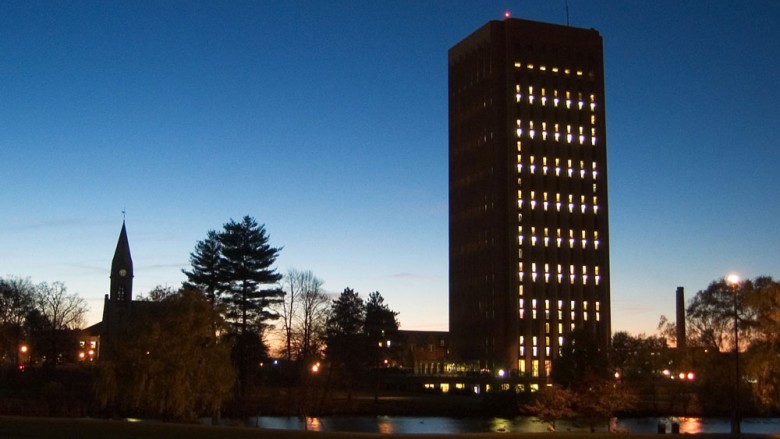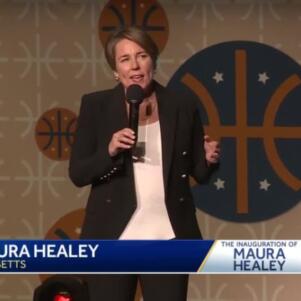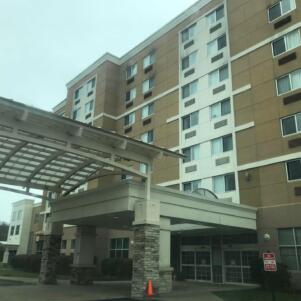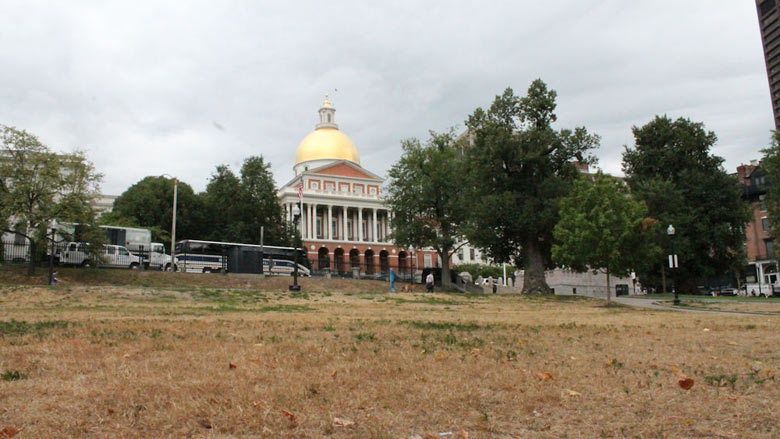Tuition costs at UMass should — and can — go down
By Mary Connaughton and Lauren Corvese | November 13, 2015, 6:19 EST
 UMass-Amherst chapel and library in the evening (Wikimedia)
UMass-Amherst chapel and library in the evening (Wikimedia) Since 2008, tuition at Massachusetts public four year colleges has increased more than 21 percent, according to the Center on Budget and Policy Priorities. In June, the University of Massachusetts Board of Trustees voted to raise tuition and fees for the 2015-16 academic year by more than 5 percent.
Students, faculty, Senate President Stan Rosenberg (D-Amherst) and Republican Governor Charlie Baker all called for the hike to be rescinded. With in-state residential students at UMass-Amherst paying $25,674 this year, the Trustees should listen.
In late July, the state legislature finally approved a $531 million appropriation for the University, an increase of $20 million over the previous year. UMass claims state funding for the 2016 fiscal year is insufficient, since their original request of $578 million, which was nearly a $60 million year to year jump.
The current legislative debate over the $10.9 million in additional funding needed to cover collectively bargained raises is trivial compared to UMass’ broader financial picture.
Administrative spending and capital projects are the primary cost drivers in the UMass system. In 2014, UMass-Amherst alone spent $2.5 million on the head basketball and football coaching positions. But consider that from 2010 to 2014 spending on administration has risen by a whopping $84 million (a 33 percent increase).
But UMass has been on a capital spending spree. Capital costs financed through debt increase interest expense, an operational cost of the school. As of December 2014, the system was dedicating over $200 million in “local funding” — stemming from tuition and fee revenues — to capital projects over the next five years. Add to that the fact that the UMass 2015-2019 capital plan aims to spend an additional $6.9 billion for construction and renovation, a jump of $2.5 billion over the previous 2011-2015 plan.
Do the growing costs advance the school’s mission “to provide an affordable and accessible education of high quality,” or are they putting public higher education out of reach for too many of the commonwealth’s high school graduates?
Job one for a state-funded university should be meeting the needs of in-state students.
And yet, between 2004 and 2014, average in-state tuition and mandatory fees across the campuses jumped 51 percent. At the same time, UMass reports that tuition and fees as a percentage of the median family income in Massachusetts increased from 12 percent in 2004 to 15 percent in 2014.
In the 10 years between 2004 and 2014, the percentage of in-state undergraduate students at UMass fell from 87 percent to 82 percent. UMass reports that “the percent has declined in recent years as the campus strives to increase enrollment of out-of-state and international students.”
Although UMass claims that out-of-state and international students are being targeted for “geographic diversity,” can there be any doubt that they are being brought in, at least in part, as a budget fix? Out-of-state students who pay heftier tuitions and international students who aren’t eligible for financial aid might help balance the books, but they still have not closed the budget gap.
Sadly, the combined impact of increased charges and targeting out-of-state and international students has appeared to reduce accessibility for many Massachusetts residents. To many, UMass’ Amherst and Lowell campuses have become “reach” schools, both academically and economically.
It’s also not surprising that system-wide, the percentage of full-time students has dropped 6.4 percent since 2004, as students opted for a part-time education because full-time attendance is no longer affordable.
Although UMass officials argue higher tuition and fees supplement financial aid for underprivileged students, the reality is that today the flagship Amherst campus meets only 82 percent of in-state students’ financial need, compared to 91 percent in 2009. That means more loans for more students. From 2010 to 2014, the average debt load of a UMass Amherst graduate rose a whopping 20 percent from more than $25,000 to over $30,000. At the current rate, the average freshman at UMass-Amherst will graduate more than $36,000 in debt.
The outrage over fee hikes is not surprising given that the increases come as UMass generated an unrestricted surplus of more than $68 million last year. That’s enough to cover tuition and fees for over 2,600 in-state students at UMass-Amherst. Plus, UMass generated an average unrestricted surplus of $64.3 million for the past five years as well. Shouldn’t that money go towards meeting the financial needs of Massachusetts students?
UMass needs to look inward and identify cost efficiencies. The university can start with the recent increases in administrative, athletic, and construction expenses. Receiving well over half-a-billion dollars in state funding, UMass’ first priority must be to ensure “an affordable and accessible high quality education” for the commonwealth’s own students.
Lauren Corvese is a Research and Programs Co-op student from Northeastern University and Mary Connaughton is Director of Government Transparency at Pioneer Institute, a Boston-based think tank.










